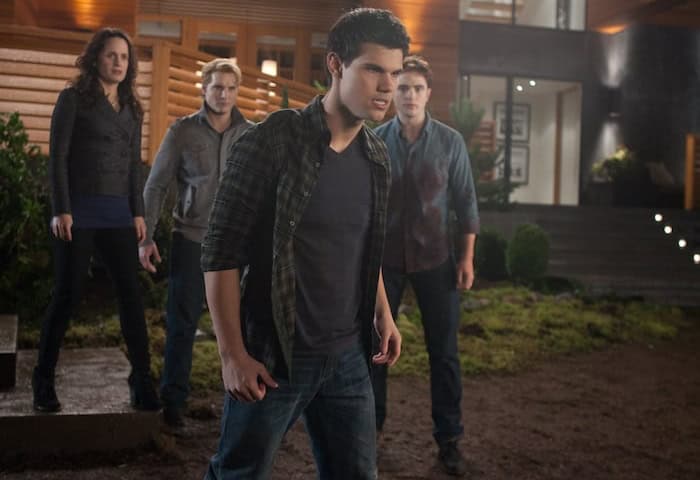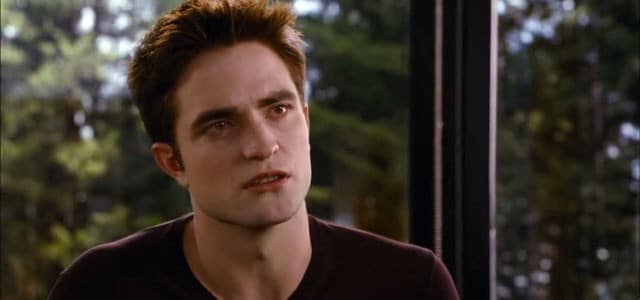32 Things We Learned from the ‘Breaking Dawn’ Commentaries

Well, Twi-hards, with the release of The Twilight Saga: Breaking Dawn – Part II on DVD and Blu-ray this week, the series has come to a final close. (That is, of course, until Lionsgate decides to reboot the franchise or Stephenie Meyer cranks out more stories in this universe. ’Cause we all know that’s gonna happen soon enough.) To help tie the final two chapters of the saga together, Lionsgate has also released the extended edition of Breaking Dawn – Part I. Both movies feature a commentary by director Bill Condon.
Now don’t worry too much. While I (and many of the writers here at Film School Rejects) am not a fan of the series at all, I can respect the fan base. This won’t be a lengthy article goofing on the flaws of the series. Instead, let’s break down what the director has to say about wrapping up the series with a one-two punch of the final book brought to life on the big screen.
And on to the commentaries…
The Twilight Saga: Breaking Dawn (2011–2012)
Commentator: Director Bill Condon
1. The first part originally opened with a scene in which the Volturi get an invite to Bella and Edward’s wedding. The scene was cut because Condon wanted to keep the full focus on Bella and have it be her story and allow the threat in this film to be more intimate. The scene was re-inserted in the extended edition for those watching both movies as a whole.
2. Both Condon and Taylor Lautner agreed that Jacob should only take his shirt off once in each of the last two films. Condon says this was because the character was growing into a man, and he was no longer a teen heartthrob (though the squeals from the audience during that scene suggest otherwise).

3. With a budget of $1m, the Cullen house was rebuilt for the Breaking Dawn films, specifically to match what was seen in the other films.
4. Condon had the make-up department noticeably tone down the vampire make-up, especially on Edward. His skin was then made more smooth and marble-like by digitally removing the grain from his face in post-production.
5. Condon’s favorite horror movie of all time is Bride of Frankenstein, which probably isn’t a surprise to fans of Condon’s film Gods and Monsters which focuses on James Whale, the director of that movie. Condon tips his hat to Bride by showing Edward watching the movie in the flashback to the 1930s.
6. At the beginning of the production, Condon combined the scripts for both films into a 222-page script rather than work from separate ones.
7. The wedding scene includes multiple crew cameos as guests, particularly Stephenie Meyer in one of the last rows. Bella nods at her on the way down the aisle.
8. The honeymoon house was shot on a set for the interiors, but the house was an actual location in Rio de Janeiro. On the third day of shooting at the location, a hurricane struck the area, and the entire cast and crew, numbering about 80 people, had to stay the night in the house. The weather following the hurricane resulted in a “gloomy honeymoon” look, causing them to shoot the beach scene on the couple’s first night together in the Virgin Islands.
9. The only part of the bed-breaking sex scene that the MPAA had trouble with was an extended thrust at the end, which had to be cut for the PG-13 rating.
10. During the beach-and-chess montage, boats of paparazzi followed the production around. Because there was no legal recourse to keep them away, the production had to put up barriers during rehearsals to discourage press, and they also had to digitally remove boats from the water in some wide shots.
11. During the shooting of the scene on the beach back in Washington in which the Quileute first discuss imprinting, the location had to be evacuated because of a warning following the Japanese tsunami.
12. Condon points to the process by which an adult can imprint on a small child as the most controversial part of the book and movie.

13. Condon sees Kristen Stewart as a would-be director, Robert Pattinson as a would-be writer, and Taylor Lautner as a would-be producer or studio head.
14. From the first time Jacob sees Bella pregnant, every shot of Stewart features some level of digital manipulation. Including these shots, there were 1400 digital effect shots in the first film. The second film had more than 2,000.
15. To avoid an R-rating for violence during the Cronenberg-esque scene in which Edward tears Renesmee from Bella’s womb using his teeth, Condon followed the rule that he could only show what Bella sees, greatly reducing the amount of on-screen bloodletting.
16. After Jacob imprints on Renesmee, there was a scene in which Edward attacks Jacob. This was removed from the theatrical version because it showed imprinting as being more creepy, which was what many critics (including me) complained about. The scene was included in the extended edition of the first film, and the concept of imprinting is discussed at the beginning of the second film in more detail.
17. Breaking Dawn – Part II is the only movie in the series that features a proper opening title sequence. Condon did this because Guild rules require the first credit to be the director’s if the opening titles are put after the film. Condon thought people would see the “Directed by” credit and leave before they saw the actors’ curtain call, which he insisted on including at the end.
18. The production originally experimented with an animatronic version of baby Renesmee, but this was abandoned in lieu of computer generated effects.
19. During Bella and Edward’s first vampire sex scene, Edward goes straight in to kiss her neck because he would have never been able to trust himself to do that while she was a human.
20. When the Cullens give Bella suggestions on how to be human, the lines about slouching and biting her lip were meant as a nod to the criticisms of Stewart’s acting from previous films. Stewart didn’t like this idea, which Condon insists was not because she was sensitive to the criticism but rather she was worried about too many meta jokes. Make of this what you will.
21. Billy Burke tried to get permission to shave his mustache because he suggested Charlie might shave for his daughter’s wedding. Condon wouldn’t let him because it was a trademark of the character. He also thought Burke was just tired of growing it and looking for an excuse to get rid of it.
22. There are noticeably fewer shots of sparkling vampires in these two films, compared to the other ones. This is because Condon wanted to keep that more subtle and less cheeky.
23. Jasper is reading a copy of Keith Richard’s autobiography when Alice has the vision of the Volturi coming.
24. Breaking Dawn – Part II had a “set containment” budget of $1 million, which was used to lock up the locations and keep people from coming onto set or getting close enough to take photographs.
25. Mackenzie Foy’s face was digitally applied to body doubles during all stages of Renesmee’s development. The first time the actress played the character completely was the scene in which Bella is reading to her in bed. However, because Foy has rather large hands and head, those had to be digitally manipulated to appear smaller than they really are.
26. The longest dialogue scene in Breaking Dawn – Part II is when Bella meets with the lawyer, played by Wendell Pierce.
27. Michael Sheen took the role in Twilight because of his daughter.
28. The only real challenge faced with the MPAA was the beheading of the vampires, in particular when Irina’s head is ripped off and Caius had his face torn in two at the jaw (which Condon points out as the single hardest shot to get past the MPAA). Not a fan of the marbled look of the dead vampires in Eclipse, Condon had the production redesign the consistency, which he describes as “somewhere where granite meets flesh.”
29. The 8-minute battle sequence at the end took a year to plan, storyboard, pre-visualize, and shoot. The first footage was shot for this scene about two years before the movie would come out.
30. Condon chose to not have the wolves shape-shift back into their human form upon death because he didn’t want the battlefield to be littered with dead, naked Quileute.
31. The test screenings for this film included a core group of about 80 people who had been in the test-screening process on all the previous films.
32. The final montage that Bella projects into Edward’s mind comprises many alternate takes from previous films, giving the appearance of familiarity but also using previously unseen footage.
Best in Commentaries
- “The big challenge number three of this film: talking wolves.”
- “Look at those guns on Kellan! It’s crazy! I don’t know what kind of steroids he’s on! (I’m kidding, Kellan.)”
- “I like to see a vampire actually kill a human.”
Final Thoughts
It’s clear from the commentary that Bill Condon was thrilled to tackle the final two Twilight films. It’s also clear that he loved the actors he worked with. He does spend far too much time gushing over Stewart and Lautner (though he promises not to at the beginning of the first commentary). He also heaps a little too much praise on supporting actors Kellan Lutz and Jackson Rathbone (two of the worst actors in the series).
Condon seems a bit nervous in his commentaries, falling into the habit of plot summary and narration. However, he does show his passion for the project and keeps things dynamic during the films. Fans of the series will enjoy the look behind the curtain at what went into the final films of this franchise. Those forced to watch the movies by their significant others will likely zone out during the commentaries as well.
